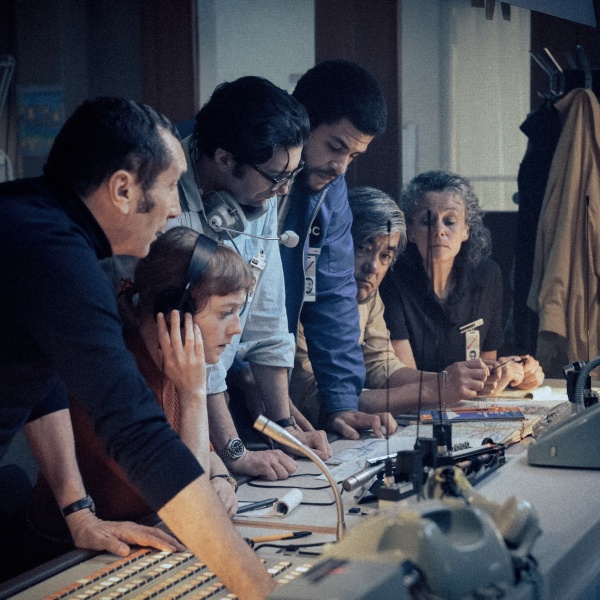This article contains IndieWire’s preliminary Best Score predictions for the 2024 Oscars. We regularly update our predictions throughout awards season and republish previous versions (like this one) for readers to track changes in how the Oscar race has changed. For the latest update on the frontrunners for the 96th Academy Awards, see our 2024 Oscars predictions hub.
The State of the Race
The original score Oscar shortlist of 15 has been whittled down to the following films: “American Fiction” (Laura Karpman), “American Symphony” (Jon Batiste), “Barbie” (Mark Ronson and Andrew Wyatt), “Elemental” (Thomas Newman), “Indiana Jones and the Dial of Destiny,” “Killers of the Flower Moon” (the late Robbie Robertson) “Oppenheimer” (Ludwig Göransson), “Poor Things” (Jerskin Fendrix), “Saltburn” (Anthony Willis), “Society of the Snow” (Michael Giacchino), “Spider-Man: Across the Spider-Verse” (Daniel Pemberton), “The Boy and the Heron” (Joe Hisaishi), “The Color Purple” (Kris Bowers), “The Holdovers” (Mark Orton), and “The Zone of Interest” (Mica Levi).
Oscar winner Ludwig Göransson (“Black Panther”) is the frontrunner for “Oppenheimer,” in which he brilliantly underscores the intensity of J. Robert Oppenheimer’s (Cillian Murphy) conflicted life as the “father of the atomic bomb.” Robertson is the sentimental favorite for “Killers of the Flower Moon,” his final score that evocatively taps into his musical Native American heritage. Karpman shines with her jazzy breakout score for “American Fiction.” And Pemberton and Hisaishi could both be nominated for “Across the Spider-Verse” and “The Boy and the Heron,” which face-off for Best Animated Feature.
For Christopher Nolan’s “Oppenheimer,” Göransson wrapped his crucial theme around Murphy’s nuanced performance. That meant reflecting the mood of every emotion surrounding his obsession with quantum physics, the pressure to build the bomb to end the war, the fear of ending the world, and the aftermath of the war and the ensuing Cold War nuclear arms race. It all began with a solo violin, at the director’s request, which the composer transformed into a series of romantic, manic, neurotic, or horrific musical changes throughout Oppenheimer’s journey. By contrast, he used a harp to underscore the Salieri-like rival, Admiral Strauss (Robert Downey Jr.). The hardest part was actually composing suites for the parallel courtroom dramas.
Robertson’s career-defining score for “Killers of the Flower Moon” caps his special collaboration with Martin Scorsese. Their association began with “The Last Waltz,” the farewell concert of The Band filmed by the director in 1976, and continued with Robertson serving as musical consultant, soundtrack supervisor, and composer. For this celebration of the Osage tribe in Oklahoma in the 1920s, when they were systematically murdered for their oil-rich land and accumulated wealth, Robertson’s score “pounds along with the beat of drums and shakers, chords splashing on acoustic and electric guitars, accented with banjo twangs and the birdlike cries of various flutes.”
Karpman brought her extensive jazz expertise to Cord Jefferson’s “American Ficton,” the satire concerning “Black” entertainment’s tired and offensive tropes. It’s about Thelonious Monk Ellison (Jeffrey Wright), an out-of-touch novelist who anonymously mocks the state of “Black” culture, and ironically becomes a celebrity. Karpman focuses on two themes: “Monk’s Theme,” which plays with the craggy edges of both the protagonist and his musician namesake, and the “Family Theme,” which cradles the contours of love and harmony in sync but not always played perfectly together.
With “Spider-Man: Across the Spider-Verse,” producers Phil Lord and Chris Miller introduced several new dimensions and characters to expand the epic journey of Miles Morales (Shameik Moore). These include Gwen’s (Hailee Steinfeld) watercolor home and the exotic Mumbattan. Pemberton got to expand his score with new themes but also have his existing themes pay off in different ways. There are more experimental sounds, including whistles recorded in a graveyard in Peckham, London, and the return of record-scratching. “Pemberton’s score makes masterful use of repetition, repurposing the main theme throughout its over 30 tracks,” IndieWire’s Proma Khosla noted.
Hisaish provides a sublime score for Hayao Miyazaki’s most personal film, “The Boy and the Heron,” about destruction, loss, and rebuilding a better future in Japan after World War II through imagination. This marks their 14th collaboration together, and it was very unusual: Most of the film was actually completed before the composer began his score, and, for the first time, he was left to his own creative devices. So he made it personal through a musical connection to Miyazaki and Studio Ghibli. In fact, a short tune that he composed for Miyazaki’s birthday became the film’s theme (“Ask Me Why”). In keeping with the film’s split between a somber reality and fantastical adventure, Hisaish started with minimalism and expanded into full orchestra, anchored three times by the intimacy of the piano-driven “Ask Me Why.”
Giacchino reunites with J. A. Bayona (“Jurassic World: Fallen Kingdom”) for Spain’s international Oscar entry, “Society of the Snow”: the survival thriller that retells the true-life story of the Uruguayan rugby team that crash-landed on a glacier in the heart of the Andes in 1972. The composer was mindful that this traumatic experience was about waking up in an alien environment, taking one excruciating step at a time, and not knowing what the next moment would bring. He used musical elements to provide just enough sense to evoke the place: the Andean string instrument called a charango and tambores de candombe, the Uruguayan drums, and the vocals are in Mapuche, an indigenous language of the region.
Levi reunites with director Jonathan Glazer on “The Zone of Interest,” the acclaimed Holocaust drama about the banality of evil. Loosely based on the Martin Amis novel, it explores the Auschwitz commandant Rudolf Höss (Christian Friedel ) and his wife (Sandra Hüller), an avid gardener, as they attempt to build a dream life with their family in the surrounding countryside next to the camp. Levi’s angular, arresting, disquieting score suggests a descent into hell in contrast to the placid exterior drama.
Alexander Payne’s “The Holdovers,” a 1970 Christmas dramedy about the misadventures of a teacher (Paul Giamatti), who remains at school over the holiday to supervise students unable to journey home, covers a lot of aesthetic ground in Orton’s thematic score. From spare underscore (solo piano, string quartet, and acoustic guitar-based cues), to chamber orchestra cues (with nods to the Christmas setting), to cues based on early ’70s classic rock sound, it balances between comedy and drama.
Greta Gerwig’s billion-dollar blockbuster “Barbie” provided emotional and whimsical inspiration to composers Ronson and Wyatt in conveying Barbie’s (Margot Robbie) existential journey in and out of Barbie Land and the real world and her interactions with Ken (Ryan Gosling) and the other dolls. Ronson and Wyatt reverse-engineered the score from such key songs as “I’m Just Ken” and “Dance the Night, using the rise and fall of disco as a metaphor for Barbie. Not only were there an assortment of harmonies and melodies to layer in but also textures, sonics, and rhythms. They also balanced analog synths and orchestra. Thus, the connection between the score and songs became its own creative journey. The biggest challenge is not being overshadowed by the Oscar-contending hit songs (which also include “What Was I Made For?”).
Willis follows up his BAFTA-nominated “Promising Young Woman” score by leaning into a classical and gothic language of organ and strings to represent the opulent and decadent world of Emerald Fennell’s “Saltburn.” It’s an evolving score that follows Oliver (Barry Keoghan) on his journey through loneliness, grand aspirations, romance, and lust. The music hides in plain sight but, like Oliver, subverts what we’ve experienced with “deep metallic harp, romantic string chords ascribed to a raw timbre, and a throbbing organ, like the sultry afterglow of a party synth seeping through the bedroom ceiling,” Willis told IndieWire.
Fendrix makes his film score debut with Yorgos Lanthimos’ “Poor Things,” and his dissonant and melodic fusion perfectly captures the delirious state of mind of Emma Stone’s Bella, who’s reanimated by unconventional scientist Baxter (Willem Dafoe) with the brain of her unborn child, and is transformed into a Victorian free spirit in this “Frankenstein” gender-bender. He creates biomechanic music with woodwinds, pipe organs, uilleann pipes (similar to Irish bagpipes), a lot of synthesized breath, and vocals to evoke a childlike sense of wonder and tactile garishness and poisonous textures.
Bowers gets to explore his arsenal of jazz, soul, hip-hop, and classical for Blitz Bazawule’s “The Color Purple,” adapted from the Broadway stage musical, and Ava DuVernay’s “Origin,” inspired by Pulitzer Prize winner Isabel Wilkerson’s nonfiction book “Caste: The Origins of Our Discontents,” which examines segregation and inequality.
As for the rest: Although “Dial of Destiny” was a box office failure, Williams hit all the right emotional musical moments for Indy’s (Harrison Ford) final adventure. The elderly archaeologist struggles to find his heroic place in a world that has passed him by, haunted by demons from the past, and Williams balances the familiar iconic themes with new ones built around his mood swings and relationships with Marion (Karen Allen) and goddaughter Helena (Phoebe Waller-Bridge).
With “Elemental,” Newman creates a vast assortment of musical colors to convey the theme of otherness in Peter Sohn’s fantasy about the elements of water, air, earth, and fire trying to co-exist in the same city. “American Symphony,” the Netflix documentary about Batiste (the Oscar co-winner for “Soul”) composing a symphony about life partner/author Suleika Jaouad coping with her cancer relapse, provided the opportunity to start from scratch with a melting pot of musicians from jazz, folk, the avant-garde, and Indigenous backgrounds.
Potential nominees are listed in alphabetical order; no film will be deemed a frontrunner until we have seen it.
Frontrunners
“American Fiction”
“Killers of the Flower Moon”
“Oppenheimer”
“Spider-Man: Across the Spider-Verse”
“The Boy and the Heron”
Contenders
“American Symphony”
“Barbie”
“Elemental”
“Indiana Jones and the Dial of Destiny”
“Poor Things”
“Saltburn”
“Society of the Snow”
“The Color Purple”
“The Holdovers”
“The Zone of Interest”



